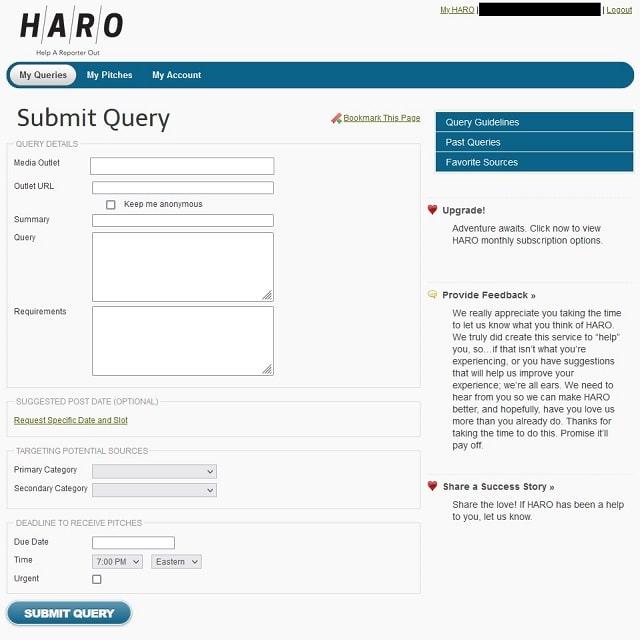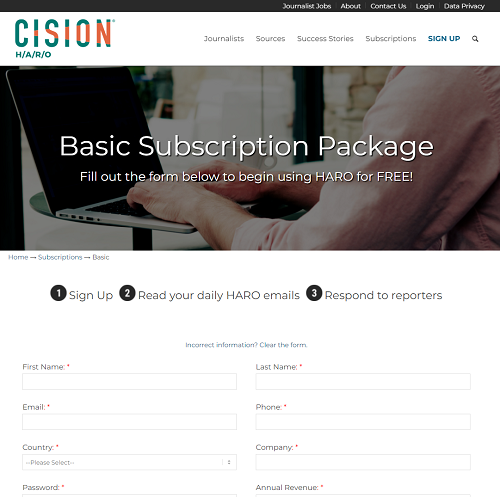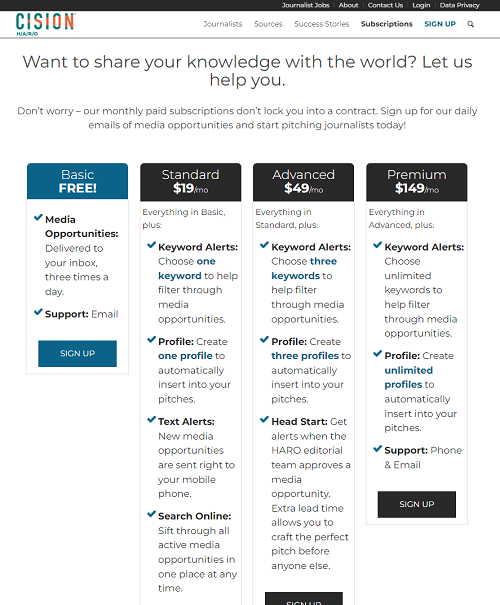
Whether you’ve been an entrepreneur for five decades or five weeks, you know the importance of getting the word out about your business. One way to earn credibility and set yourself up as a subject expert is to get featured in the media. If you know how to use HARO (an online service that connects journalists and sources), you’ll be better equipped at getting your business noticed both offline and online.
But, what is HARO and how can it get your business media attention? I’m sharing everything you need to know about HARO below, along with how you can use it in your business practices. Keep reading to learn more.
What is HARO?
HARO stands for Help a Reporter Out. It began as a Facebook group in 2008 to help reporters and journalists gain feedback directly from the public. It later transitioned into a mailing list and was ultimately acquired by Vocus, Inc., which later merged with Cision Inc.
Before HARO was around, businesses often had to pay a publicist or public relations firm thousands of dollars to be featured in a media outlet. They may have also written and sent out their own press releases in hopes of getting lucky enough to get the attention of a journalist.
These days however, getting media attention can be as easy as answering queries sent to your email via HARO. It’s essentially a media and source matchmaking platform, where people can sign up as either journalists or sources.
A business can benefit from both options by strategizing connections accordingly. I’ll explain how to use HARO in more detail below.
How to use HARO as a journalist
When journalists sign up for the platform, they can post queries related to content they are developing. This content can be:
- Podcast episodes
- Radio programs
- Web content
- Newspaper articles
- Magazine articles
- Television programs and more
If you’re learning how to use HARO for the first time, it might help to view a visual breakdown. Here’s a peek at what a blank query looks like from my own account:

The journalist shares what media outlet the content is for and the outlet’s URL. They can then choose whether to remain anonymous or publicly share where the content will be published.
Next, they will include a short summary of what they are looking for, followed by a more in-depth query. The section beneath the query is reserved for requirements that sources must meet if they hope to be selected as a contributor.
Finally, journalists will fill out the deadline and submit their queries to HARO for approval. If they are approved (and not all of them are), the queries are then sent out to an email list of potential sources.
Typically, HARO will approve or deny the query about one or two business days prior to the deadline. If a journalist has a quick deadline and needs answers the same day, they can click “Urgent” and HARO will post the query on Twitter to get instant responses.
How to use HARO as a source

When a source is exploring how to use Haro for the first time, they’ll begin with the three step sign up form. Here, they can choose the frequency of emails they receive. Emails are sent out Monday through Friday in the morning, afternoon, and evening. They are then broken down into different categories that include subjects like:
- Business and Finance
- High Tech
- Biotech and Healthcare
- Energy and Green Tech
- Lifestyle and Fitness
- Sports
- Entertainment and Media
- Public Policy and Government
- Education
- General
- Giftbag
- Travel
- UK
The queries in the emails vary greatly depending on what journalists are seeking sources for. Some sample topics might include:
- How to be successful with cryptocurrency
- The best holiday gifts for men over 40
- Tips from relationship counselors on how to find a date using online dating services
I’ve also seen generic queries and ones that are so hyper-specific, I wonder if the journalist was able to even find a source at all! You honestly never know what will pop up as a query. Plus, anyone can sign up and learn how to use HARO for free.
Alternatively, Cision also offers premium subscriptions starting at $19 a month. This paid option gives you additional opportunities to increase your chances at getting featured. But It’s worth noting that a paid subscription doesn’t guarantee you’ll be chosen as a source.
My experience using HARO
As a journalist, I’ve learned how to use HARO for many different types of stories — including this post. Some of the queries I’ve sent out include:
- Podcast promotion tips
- Travel agent success ideas
- Tax deduction advice for small business owners and more
The reason I love HARO so much is because you can be as specific as you’d like with your query. You can then find the exact sources you’re looking for to help enhance your content and add credibility to your posts.
Why I like HARO’s anonymous feature
One you understand how to use HARO a little better, you might decide to utilize their anonymous feature in the settings. I always opt to make the outlet I’m gathering materials for as “anonymous” because I don’t like to share posts until they are live – or at least guaranteed to go live. Sometimes stories get killed midway through production and it can be very frustrating when you get an email from a source wondering what happened to the post.
Breaking the news that a post never went live could be quite disappointing for any sources involved.
I’ve also noticed that disclosing your outlet’s name sometimes skews the responses you get. For example, everyone wants to respond to a query from Forbes, but they may not want to respond to a query from a smaller website.
Note: If you are a journalist representing an online-only or business website, make sure to check out the HARO rules for journalists before getting started — especially if you’re not sure how to use HARO. You don’t want to violate any rules that could deny your query or ban your account.
Keys ways HARO has helped me
I’ve also used HARO as a source for both myself and for clients I ghostwrite for. It’s a fabulous tool for:
- Getting backlinks to your website
- Establishing yourself as an expert in your field
- Contributing to the content that matters to your niche
When the queries go out in the morning, afternoon, and evening, there could be 50 or more responses per email. Again, queries are all broken down by category, so sources can skip to the subjects they want to contribute to.
I’ve never personally paid for HARO’s premium plans, and don’t know anyone who has either. But if you want to know how to use HARO with additional subscription-based features, here’s a glimpse at what they look like and what they offer:

What niches benefit the most from HARO?
I’ve yet to see a niche that wouldn’t benefit from learning how to use HARO. Because of the different categories, and the wide variety of queries created across all of the categories, I would bet that any business could find some kind of query to respond to – even if your business isn’t directly related to a category.
And, if your business doesn’t have anything to contribute the first time, you can always expect a new query within the next day, week or month.
It’s okay to hold out for the best queries you feel are a match.
Now that we’ve covered the basics of HARO, let’s take a closer look at how to use it to get your small business in the news!
How to use HARO to benefit your small business
First, the bad news. Don’t jump into HARO expecting to land a feature in Forbes the first day. While this can certainly happen, it’s highly unlikely. There are many small business owners just like you who know how to use HARO to get media attention.
Perhaps Sharon Geltner, a successful multimedia journalist who’s written for publications like Forbes and the New York Times, says it best:
“I won’t kid you, using HARO means I kiss a lot of frogs before I meet the prince. But it is well worth sorting through amphibians to eventually ascend to national media outlets – which would otherwise be very hard to do.”
With this in mind, here is my best advice on how to use HARO to get in the media:
- Have a website up and running. Make sure to have an “about” page available, so journalists can learn more about you.
- Sign up for an account as a source on HARO. This will grant you access to media queries you can respond to.
- Choose the frequency of emails you would like to receive. Email newsletters are sent out to sources three times a day and can range from 10-100 queries.
- Create a plan of attack. Think about what your business is all about, what market you are trying to serve, and which outlets align with your business values.
Editor’s note: If you need help setting up a website, check out GoDaddy’s Website Builder to easily get started with no tech experience necessary.
Pro Tip: Don’t respond to every query!
Instead, choose the ones that most resonate with your ideal audience. Seek out queries that you would be best suited as a source for.
Once you start receiving queries, read them carefully and start responding.
Be prepared to respond quickly!
Some journalists get dozens of pitches and don’t have time to read each one. They may decide to stop accepting pitches after receiving a few decent responses. Pitches that come in too late risk getting buried at the bottom of their priority list.
For example, one of my most recent HARO queries had 56 responses and I was only able to use 11. Though I got a lot of great responses, I went in the order I received them and chose the first 11 that worked for my content. I didn’t even read the rest!
However, that’s not to say you should rush when responding to queries – not by any means. Always give thorough and well thought out responses, but don’t wait several hours to figure out who you want to respond to.
Real world examples of how to use HARO for your business
To help you determine your plan of attack, let’s look at some real world examples of sources that know how to use HARO successfully.
Hugo Guerreiro, The Men Hero

Hugo Guerreiro, founder of lifestyle and men’s fashion blog The Men Hero, says that HARO has been wonderful for building his domain authority with backlinks. He says, “It’s free and takes less time than pitching to other websites to provide you with a link or write a guest post. I have built all my backlinks with HARO, since my answers have been chosen multiple times. I would advise anyone who wants to improve their blog authority to answer HARO questions.”
Jackie Blanchard, Fortress Development Solutions
Jackie Blanchard is a social media marketing specialist for the construction development company, Fortress Development Solutions. She says HARO has been great at getting “niche industry opportunities” and adds that it has also helped her company “get in front of a national audience.”
“The more articles we can collaborate in, the more opportunities our potential customers will have to find us. HARO is very user-friendly and we get emails daily with potential opportunities. I scroll through and if we’re a good fit I reach out and share our story.”
Her best advice for sources looking to get selected is to be open. “The more information you share, the more likely you will get chosen for follow-ups.” She also notes that it helps to get email notifications, so you can be among the first to respond. “Always answer all questions and offer your company for future needs.”
Additionally, your response should be thorough, yet straight to the point. I’ve gotten responses that were as short as one sentence and as long as three pages. The three pages were overkill!
Stephen Curry, CocoSign
Stephen Curry is the CEO of the online signature platform, CocoSign. He says that HARO has become the best means of getting his business featured in the media and that it has “proven to be the best backlink generation technique.”
His best advice for sources is to:
“Read the requirements that the reporter has given. If you feel that you have a unique point of view and insight on that query, use your best words to describe it as clearly as possible, and you’ll see that query getting accepted in no time. The chances of getting selected as a source get much higher when you provide credible content in less time.”
Related: How to get backlinks to a small business website
Patty Malowney, Badass Web Goddess

Patty Malowney is the social media marketing and SEO expert for Badass Web Goddess. Her best advice on how to use HARO is to:
“Use HARO consistently every day. They send out queries three times a day. Go through every single one of them. If you miss one, you could miss an opportunity. When you find a query that interests you, respond back promptly. Make sure what you write is quote-worthy. Think about whether or not the author can easily use what you say in a quote. If not, condense what you have to say into a bite-size quote.
Don’t get discouraged. You have to send pitches regularly and be patient. Sometimes you won’t hear anything back for a month or longer. If you stick with it, you’ll get better at your pitches and will be selected more often.”
Alex Shute, FaithGiant
Alex Shute, founder and chief editor of the Christian lifestyle website FaithGiant, says, “HARO has been a reliable source of media attention for our website and the best way to utilize HARO is to choose queries that are related to your website’s main topic and interest.”
His best advice for getting selected as a source is to write answers that are “straight to the point yet incorporate your own experiences related to the queries.” He also adds that your goal for answering should be “both helpful and genuine.”
When it comes to the length of your answers, Shute recommends aiming for a happy medium:
“It’s all about finding the right balance between one that’s short enough for both the recipient and the would-be readers to not lose interest easily, but also be long enough to be informative, engaging, and compelling. This can be the difference between someone opening it or sending it to the trash. A well-written answer to the HARO query can save the day.”
Remember, the end-game is to offer answers with substance in a timely manner.
Greg Jenkins, Bravo Productions
Greg Jenkins, founder and partner of Bravo Productions, has been using HARO for the last 13 years. He says “it has been a great experience in not only getting our company’s name out to global audiences, [but] it’s also been beneficial in educating consumers and various audience demographics about the profession.”
To highlight his point, Jenkins notes that “topics run the gamut” and can include examples like:
- Quick party fixes for Health & Fitness Magazine
- Budget tips for websites like Brides.com
- Super Bowl party tips for publications like the Atlanta Journal & Constitution
- Party planning advice for Costco Connection Magazine
- Security and risk management advice for publications like Smart Meetings
He takes things a step further by sharing any content his company is mentioned in on Twitter, Facebook, LinkedIn and more. This helps Jenkins:
- Build up his social fan base
- Set himself up as an expert in event planning
- Increase brand awareness
Knowing how to use HARO helps give your small business the upper hand in marketing and Jenkins reports:
“We find using HARO is a means to distinguish our company from the masses and competitors. There are a plethora of event and party planning companies in every city. When included in an article, it’s one way to distinguish our company from those who may not receive the same media exposure.”
His best advice for a source is to, “Be specific in your answers. Vague responses to questions will not help the journalists or the end reader if your input adds little to nothing in the story.”
Jenkins also adds that you’ll want to make sure you edit and utilize spell check for grammar before sending responses to journalists. He suggests keeping an eye out for typos and making yourself available for any follow-up questions.
Linda Pophal, Strategic Communications
Linda Pophal, founder and owner of Strategic Communications, uses HARO as both a source and a journalist. She says the most important thing is to “only respond to pitches that you are truly qualified for.”
Pophal also notes that HARO, in her opinion, has been overrun “by trash responses from people [clearly] seeking only to attain backlinks.” She adds that these responses often use content generation tools to develop their responses, which typically don’t offer any valuable insights to her queries.
“If you don’t have the credentials [or] expertise the reporter is looking for, don’t respond. If you do, and do so repeatedly, you’ll fall off their radar screen and likely be blocked. I have a number of names I’m now familiar with that I now delete responses from without even looking at them because their input has been so irrelevant or off the mark.”
Finally, she acknowledges that journalists are busy and more likely to use “detailed written responses than to take time to interview sources.”
“Providing relevant detailed information can boost the odds that your input will be used. A side benefit is that, since you’ve actually documented your response you’re more likely to be quoted accurately.”
Ryan Stewman, Break Free Academy

Ryan Stewman, founder of Break Free Academy, reports that the two most important things for him are consistency and delivering value. He says:
“I’ve been using HARO for three years now. I answer one to two email queries daily. If you add it up, that’s 700 or so opportunities per year to get published from HARO.”
When it comes to getting published, Stewman says his experience as a source is to “give the reporter the information they are looking for.”
“Most people fail to get published because they made their replies about themselves, instead of about the needs of the reporter. The key to getting the most out of HARO is to consistently answer queries daily, and answer them according to what you think the reporter wants information on, not about yourself.”
Key takeaways and next steps
To close things out, I’ve rounded out some final tips to get your business featured in the media using HARO:
- Don’t wait. Start learning how to use Haro right away. There are hundreds of opportunities every week, and your business might have the exact insights journalists (like me) are looking for.
- Give thorough and valuable responses. Read queries carefully and answer all questions appropriately. If you want to get selected, holding back won’t do you any good.
- Answer truthfully and don’t hype yourself up. No one likes to find out their source isn’t as amazing as they claim to be. It’s also a quick way to land yourself on a blacklist for many websites.
- Have a bio and headshot ready. Many journalists will want to feature your information alongside your quote or answer to a query.
- Don’t forget to include contact information. Add this to your emails in case a journalist wants to follow-up.
- Keep pitching via source requests. You never know who is looking for a source, or which pitches will be selected.
What are you waiting for? Sign up for HARO and start working on getting your business in the news today!